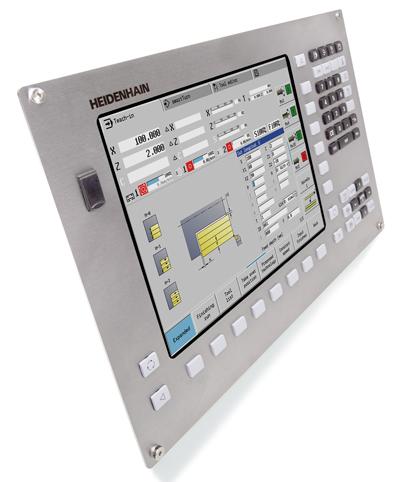
HEIDENHAIN has released the newest software and hardware for its contouring control for CNCs and cycle lathes, the MANUALplus 620. The MANUALplus 620 control is compact and versatile, and is characterized by its simple operation and programming.
The new end-user features now available through the MANUALplus 620 are complete support of the opposing spindle during automatic program generation. Also, the cut-off cycle G859 now permits entering a default diameter at which a pick-up device is activated, and the rotational speed can also be limited. In the ICP editor, a calculator for fits and internal threads is now offered with the respective input fields for the parameterization of holes and threads.
With this MANUALplus 620 lathe control, the machine builder will welcome HEDEINHAIN's new generation of main computers with more powerful processors and performance reserve for future expansions. Due to the reduction in structural width to 22 nm, the new Intel Celeron processor with Ivy Bridge architecture provides increased computing power while consuming less electrical power. There are also sufficient performance reserves for future expansions of the MANUALplus 620.
A PROFIBUS interface card can be plugged externally via PCI express slot. It features a USB 3.0 interface and an 8 GB CFR with CFast (S-ATA interface) for faster data access. The new CFR MANUALplus 620 is based on the CFast standard (CFast = CompactFlash ATA Serial Transfer). Compared to the previous CFR memory cards, the faster S-ATA protocol is used for the new mass storage device.
The new cards have significantly shorter access times, which is convenient, for example, during startup of the MANUALplus 620 and handling of large NC programs. OEM cycles and OEM subprogram dialogs can now be shown with language-sensitive texts. Special working-space limits (area limit switches) can now be defined for machines with inclined kinematics (e.g. oblique axis).
Contact Details
Related Glossary Terms
- lathe
lathe
Turning machine capable of sawing, milling, grinding, gear-cutting, drilling, reaming, boring, threading, facing, chamfering, grooving, knurling, spinning, parting, necking, taper-cutting, and cam- and eccentric-cutting, as well as step- and straight-turning. Comes in a variety of forms, ranging from manual to semiautomatic to fully automatic, with major types being engine lathes, turning and contouring lathes, turret lathes and numerical-control lathes. The engine lathe consists of a headstock and spindle, tailstock, bed, carriage (complete with apron) and cross slides. Features include gear- (speed) and feed-selector levers, toolpost, compound rest, lead screw and reversing lead screw, threading dial and rapid-traverse lever. Special lathe types include through-the-spindle, camshaft and crankshaft, brake drum and rotor, spinning and gun-barrel machines. Toolroom and bench lathes are used for precision work; the former for tool-and-die work and similar tasks, the latter for small workpieces (instruments, watches), normally without a power feed. Models are typically designated according to their “swing,” or the largest-diameter workpiece that can be rotated; bed length, or the distance between centers; and horsepower generated. See turning machine.
- numerical control ( NC)
numerical control ( NC)
Any controlled equipment that allows an operator to program its movement by entering a series of coded numbers and symbols. See CNC, computer numerical control; DNC, direct numerical control.

